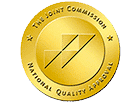As the opioid epidemic continues to wreak havoc across the nation, illicit drug traffickers have found new ways to continue pushing their products to the public. One new tactic is the distribution of brightly colored fentanyl pills, or “rainbow” fentanyl. We’ve seen tobacco companies and others target children to use their products using similar marketing tactics. The bright-colored pills are supposed to attract younger people to use them.
With this new tactic, fentanyl has been able to reach more communities and unsuspecting consumers. In light of the increased dangers the drug rainbow fentanyl poses, it is more important than ever to know how to recognize this substance and what to do should you come into contact with it. Law enforcement agencies across the country are spreading the word on social media and elsewhere about the dangers of these brightly colored pills and the public health crisis they could be.
What Is Fentanyl?
Fentanyl is a highly potent and dangerous synthetic opioid drug that is considered to be 50 to 100 times more potent than other opioids like morphine and heroin. While fentanyl has been approved by the FDA as an analgesic pain reliever and anesthetic, it also poses a high risk for opioid overdose and addiction.
Fentanyl, like other opioids, interacts with opioid receptors in the brain that are involved in producing feelings of pain and pleasure. It triggers the brain’s reward systems, essentially reinforcing the action of taking fentanyl. This can produce feelings of relaxation, euphoria, pain relief, and sedation, as well as make the brain crave continuous use of the drug to prolong this reaction, which is what makes this drug so prone to abuse.
What Is Rainbow Fentanyl?
Rainbow fentanyl is a dangerous illicit drug that has gained national attention for its deceptive appearance. Often referred to as colored fentanyl, this potent synthetic opioid is manufactured in bright hues and sometimes disguised in candy packaging, making it especially alarming to parents and authorities. The Drug Enforcement Administration (DEA) has warned that these tactics may be used to target younger individuals, particularly around holidays like Halloween, when concerns about drugs hidden in Halloween candy are heightened. Despite its colorful look, rainbow fentanyl can be lethal, with even trace amounts capable of causing a fatal drug overdose.
As of 2022, the Drug Enforcement Administration (DEA) has announced warnings to the public on the danger of brightly-colored fentanyl being used by drug dealers to avoid detection and appear more appealing to teenagers and impressionable children. This so-called “rainbow” fentanyl can come in the form of pills, powders, or even chalk-like blocks. No matter what shape this drug takes, it is extremely dangerous, especially to unsuspecting consumers.
With the increase of reported cases of rainbow fentanyl, many parents and communities face concerns over their children being tempted with fentanyl “candy” due to the drug’s bright and fun appearance. The goal is to use candy packaging to have as many similarities to candy as possible. As one of the leading causes of death for Americans between the ages of 18 and 45, it is important to know how to recognize fentanyl in all of its shapes, sizes, and colors. There’s evidence some instances of this deadly drug may come to the country from illegal factories in Mexico via drug cartels. Some worry the pills may find their way into Halloween candy, though accounts of this happening are rare.
Is Fentanyl Dangerous?
Despite its potentially harmless appearance, fentanyl is extremely dangerous. As a highly potent synthetic opioid, even a small amount of fentanyl can be deadly, especially for people who are not used to taking opioids or who are taking it unknowingly.
Fentanyl is often mixed with other drugs, such as heroin, cocaine, and methamphetamine, without the user’s knowledge. This is because fentanyl is cheap and easy to produce, and it can make other drugs more potent.
However, this also makes it very difficult to know how much fentanyl you are actually taking, which can lead to overdose and death. Fentanyl is also dangerous because it is odorless, tasteless, and colorless, meaning it is impossible to tell if a drug contains fentanyl without testing it.
One of the biggest risks associated with this drug is the high likelihood of overdose that comes with taking it. According to the National Institute on Drug Abuse, a staggering 70,601 overdose deaths involving synthetic opioids, primarily fentanyl, were recorded in 2021. Unfortunately, these numbers have only continued to increase over the years.
In light of the rise of rainbow fentanyl distribution and the dangers this drug continues to pose for communities across the country, the need for effective addiction prevention and treatment options has become more important than ever.
Are you struggling with fentanyl addiction?
Royal Life Centers is here to help you recover. Because we care.
Fentanyl Treatment Options
There is no one-size-fits-all approach to fentanyl treatment, but there are a number of effective options available. The best treatment plan for each individual will depend on a variety of factors, including the severity of their addiction, their medical history, and their social support system.
For most people, their recovery process will start with medical detoxification. This is the process of safely withdrawing from fentanyl and can be done comfortably under the supervision of a medical professional.
Medication-assisted treatment (MAT) is another type of treatment used to help people recover from opioid addiction. These medications work by binding to the same opioid receptors in the brain as fentanyl, but they do not produce the same high.
This can help to reduce cravings and withdrawal symptoms, making it easier for people to stay sober. The three main medications used to treat fentanyl addiction include:
- Buprenorphine (Subutex, Suboxone): This is a partial opioid agonist, which means that it binds to opioid receptors but does not produce a full high.
- Methadone: Methadone is a long-acting opioid that produces more mild effects, which means that it can help to reduce cravings and withdrawal symptoms for up to 24 hours.
- Naltrexone (Vivitrol): Naltrexone is an opioid antagonist and blocks opioid receptors from binding to opioids, helping to prevent people from getting high if they relapse.
Behavioral therapy is also commonly used for treating opioid addiction by helping people change their thoughts and behaviors related to substance use. Behavioral therapy can be used in conjunction with MAT or on its own.
Some common types of behavioral therapy used to treat fentanyl addiction include cognitive-behavioral therapy (CBT), contingency management, and motivational interviewing. Support groups can also provide recovering individuals with a safe and supportive environment to share their experiences and learn from others who are in recovery.
When finding a licensed fentanyl recovery clinic, it is important to look for a treatment provider that offers individualized and well-rounded care. Addiction treatment is not a one-size-fits-all approach, so it is important to find a treatment center that is willing to work with your specific needs.
Fentanyl Treatment at Royal Life Centers
In response to the growing threat of rainbow fentanyl, Royal Life Centers offers the comprehensive care you or a loved one needs to overcome an addiction to this substance. Our treatment programs offer several levels of care, including:
- Medical detox
- Inpatient and residential treatment
- Partial hospitalization
- Intensive outpatient treatment
- Behavioral and holistic therapies
- Aftercare
Making the decision to put your addiction behind you and seek help can be scary, but with the right treatment and support, sobriety is possible. If you suspect a loved one is using fentanyl after finding brightly colored drugs or from other situations like their social media postings, call us today.
Making the decision to put your addiction behind you and seek help can be scary, but with the right treatment and support, sobriety is possible. Our programs for mental health and substance abuse are designed to prevent an opioid overdose in the future as well as teach people about the dangers of addiction. Reach out to us today to learn more about how our programs can be a great fit for you.






